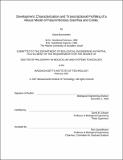Development, characterization and transcriptional profiling of a mouse model of fatal infectious diarrhea and colitis
Author(s)
Borenshtein, Diana
DownloadFull printable version (7.020Mb)
Other Contributors
Massachusetts Institute of Technology. Biological Engineering Division.
Advisor
David B. Schauer.
Terms of use
Metadata
Show full item recordAbstract
Citrobacter rodentium is a naturally occurring murine bacterial pathogen which is used to model human diarrheagenic E. coli (EPEC and EHEC) infections in mice. C. rodentium causes colonic hyperplasia and a variable degree of colitis and mortality in the majority of inbred and outbred lines of mice. Differences in C. rodentium-induced disease are determined by the genetic background of the host. Here, C. rodentium infection in resistant outbred Swiss Webster (SW) mice was compared with infection in the cognate inbred FVB strain for the first time. In contrast to subclinical infection in SW mice, adult FVB mice developed overt disease with significant weight loss, severe colitis, and over 75% mortality. Fluid therapy intervention completely prevented mortality in FVB mice, and expression of pro-inflammatory and immunomodulatory genes in the colon was similar in both lines of mice, suggesting that mortality in C. rodentiuminfected FVB mice is due to hypovolemia resulting from severe dehydration. To identify host factors responsible for the development of mortality, gene expression in the distal colon of FVB and SW mice was investigated using a whole mouse genome Affymetrix array. (cont.) Transcripts represented by 1,547 probe sets (3.4%) were differentially expressed between FVB and SW mice prior to infection and at 4 and 9 days post-inoculation. Data analysis suggested that intestinal ion disturbances rather than immune-related processes are responsible for susceptibility in C. rodentium-infected FVB mice. Marked impairment in intestinal ion homeostasis predicted by microarray analysis was confirmed by quantitative RT-PCR and serum electrolyte measurements that showed hypochloremia and hyponatremia in susceptible FVB mice. C. rodentium infection was next characterized in additional inbred strains of Swiss origin. SWR and SJL mice developed minimal morbidity and no mortality in response to the pathogen, demonstrating resistance to disease. Furthermore, C3H mice developed severe diarrhea and gene expression changes comparable to those in infected FVB mice, suggesting common pathogenic mechanisms in susceptible strains. In conclusion, C. rodentium infection in FVB mice is a useful model for fatal infectious diarrhea. These studies contribute to our understanding of C. rodentium pathogenesis and identify possible candidates for susceptibility to fatal enteric bacterial infection.
Description
Thesis (Ph. D.)--Massachusetts Institute of Technology, Biological Engineering Division, 2007. This electronic version was submitted by the student author. The certified thesis is available in the Institute Archives and Special Collections. Includes bibliographical references (p. 195-208).
Date issued
2007Department
Massachusetts Institute of Technology. Department of Biological EngineeringPublisher
Massachusetts Institute of Technology
Keywords
Biological Engineering Division.